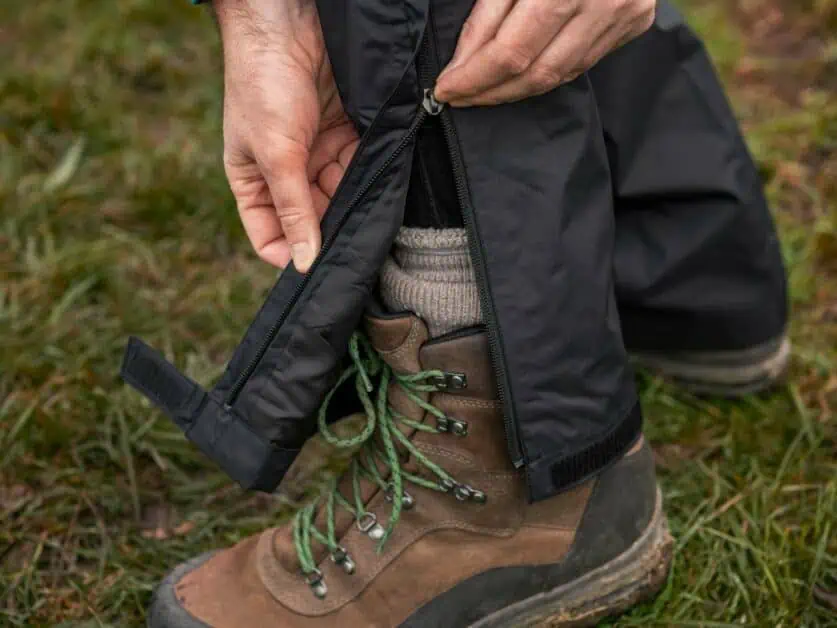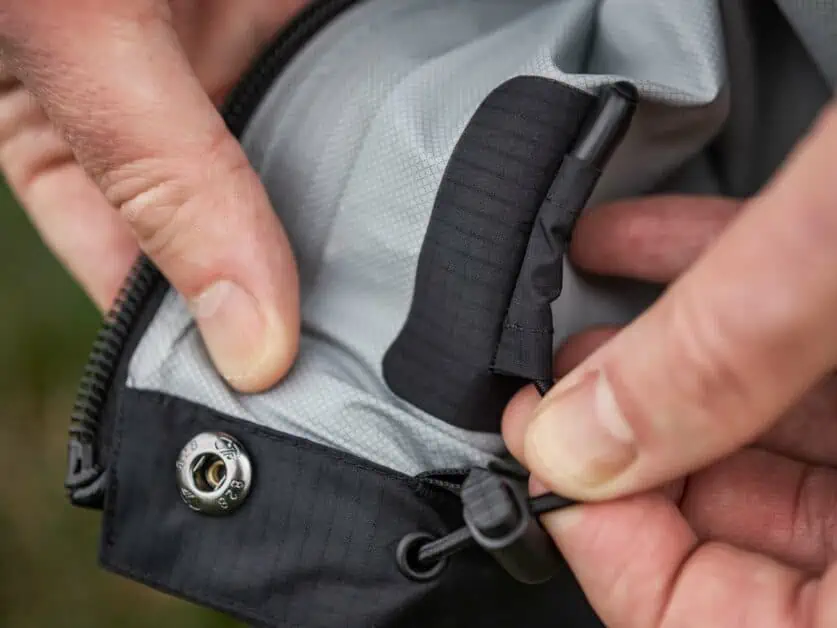Table of Contents
ToggleWhere We Test
When it comes to rain pants and all rain wear in general, the best place to test is in the great outdoors, where you’ll be spending most of your time. We are looking for real life scenarios and how the different rain pants we’ve recommended will perform in different conditions. Of course, testing in a laboratory in fixed conditions is great and we’re glad manufacturers do this, but getting out in the field is what allows us to make our recommendations for you. For example, you’ll want to know how easy they are to put on whilst you’re actually outdoors, how they feel on the body after building up some sweat, and a whole number of other concerns.
Editor’s note: This article is part of our buyers guide to waterproof rain pants. See other articles in this series:
- 9 Best Waterproof Rain Pants for Hiking
- How to Choose The Right Waterproof Rain Pants For Your Hike
- Compare Waterproof Rain Pants & Trousers
- Water Resistant vs Waterproof vs Water Repellent – What is the Difference
Looking for other waterproof gear? Check out our buyers guides on waterproof hiking shoes and waterproof rain jackets.
Testing Metrics
We’ve spent a long time carefully putting together the metrics that we use to decide whether to make a recommendation to you or not. These can be similar over a lot of our guides, but there is of course variance depending on the products we’re testing. Having tested a lot (and we mean a lot) of pairs of waterproof pants and trousers, we were able to look at how water resistance, comfort and feel, price and various other features combine to make the best products. Generally, we found that products that offer a good sense of breathability whilst also offering comfort and less noise whilst wearing were our favorites.
Materials
Each manufacturer makes use of different materials for their waterproof pant and trouser offerings. Some brands have in house waterproofing fabrics, others have collaboration fabrics and others make use of stand-alone brands like Gore-Tex in their construction. You’ll generally find that the materials used on waterproof pants will depend on how much the pants themselves are priced at – the usual trend is the more you pay the more technical fabrics you get. Fabrics like polyester, ripstop nylon, and Gore-Tex were all popular materials for rain pants.
When testing we were looking at how the price of each pant compared to the materials used and if you were really getting value for money. Pants are also something that can come up against a lot of wear and tear – they are much closer to the ground and can be subject to rips and scratches, so we were also looking at the durability of the material, and how this also factored into the price.

Water Resistance
At This Expansive Adventure, we know a thing or two about rain, so when it comes to testing water resistance in any product, we do not have any trouble getting the right conditions to test in! Each product makes use of its own waterproofing method, from own brand solutions such as Omni-Tech and DryVent through to Gore-Tex Pro, Gore-Tex PacLite and Pertex Shield. These technologies all aim to produce a product that is resistant to water – but to what degree? We’ve tested the waterproof pants we’ve recommended to you on all types of rain, from driving storms through to light rain – they all count. We were looking for what products gave the best waterproofing over a variety of conditions, and how this affected breathability and comfort.
Breathability
You may think that when something is intended for waterproofing, that it may not be as breathable, and whilst a waterproof product isn’t as breathable as a lightweight mesh layer, technology has come on a long way in recent years. There are some great waterproof and breathable products on the market and brands are constantly working to improve how the breathability and waterproofing of their products work together.
When you’re working up a sweat in the outdoors, much the same as waterproof rain jackets, you will be looking for a product that keeps you dry whilst wicking moisture from the skin. The water repellence is extremely important to the breathability, as the various technologies from different layers of the fabric all work together to create breathability. We tested this through rigorous activity in demanding terrain.
Comfort and Mobility
Waterproof pants can feel stiff and rigid – they are essentially a lighter version of a waterproof jacket. This can of course affect comfort and mobility. We tested this in a variety of scenarios outdoors, from alpine environments where you can expect to need to stretch your legs longer and stride further, through to how the rain pants feel to sit down in too. We were also looking at how the fabrics used create noise (that kind of swooshing sound) and how much of an impact that had on overall comfort and wearability. We also looked at how each pair felt to wear over various other layers – generally rain pants will be worn over either a base layer or another pair of hiking pants.
Features
Waterproof rain pants will often come with a number of features, such as built-in belts, fasteners, adjusters, pockets, be convertible, offer roll-up and have articulated knees amongst others. Some have more features than others, and some are actually extremely minimal in extra features. In our tests, we were looking to see how the various features on offer in each pair of rain pants improved user experience, and if they made a significant difference to their weather protection and wearability.

Durability
Waterproof pants are likely to come up against a lot more in terms of bumps, scrapes and potential dangers that could rip them in the outdoors. They are closer to the ground and are one of the items you’ll wear that are the most likely to be damaged. When testing the durability of waterproof pants, we were looking at the various materials used to help with rips – such as ripstop nylon and ripstop fabrics. We were also looking at how waterproof taping was used or stitching and flaps to ensure waterproofing stays as durable as possible.
Appearance
We don’t feel that waterproof pants for hiking are the most glamorous looking product, but some of them look more inobtrusive than others. We kept in mind how the appearance of each pant we tested actually felt to wear – were they shinier, or matt, did they have a lot of pockets/zips, for example. Whilst many outdoorsy people will say that the way their product looks isn’t particularly important, this isn’t the case for all, and some products certainly look more stylish than others. Especially if you want to wear your pants around town after your hike.
Weight and Packability
We tested the weight and packability of the waterproof pants in our line up by doing exactly that – weighing them up and packing them down to see how they packed away in a backpack. In terms of weight tests, we also tested how heavy they felt to wear and if this had an impact on movement and comfort, especially in heavy rain.
Price
As with all of our product round ups, we believe that price should not be a barrier to the outdoors, and whilst it’s possible to spend a huge amount of money on gear, it’s also possible to spend a lot less. There should be no shame in this, and there can be a whole range of reasons why you may not want to spend so much on your waterproof pants. We were looking at price as one of our main factors in all of our tests, and how the price of each product lined up to its durability and overall design. Most importantly we were looking to see if the price was actually worth what you get for it in the quality of the product.
Disclaimer: This article contains Affiliate Links. You won’t pay any more for buying through these links, but we may receive a commission from any purchases made through them. As an Amazon Associate, I earn from qualifying purchases. If you choose to support us by buying through our links, we thank you as it helps us to continue providing the resources we do to help you enjoy the outdoors more!
